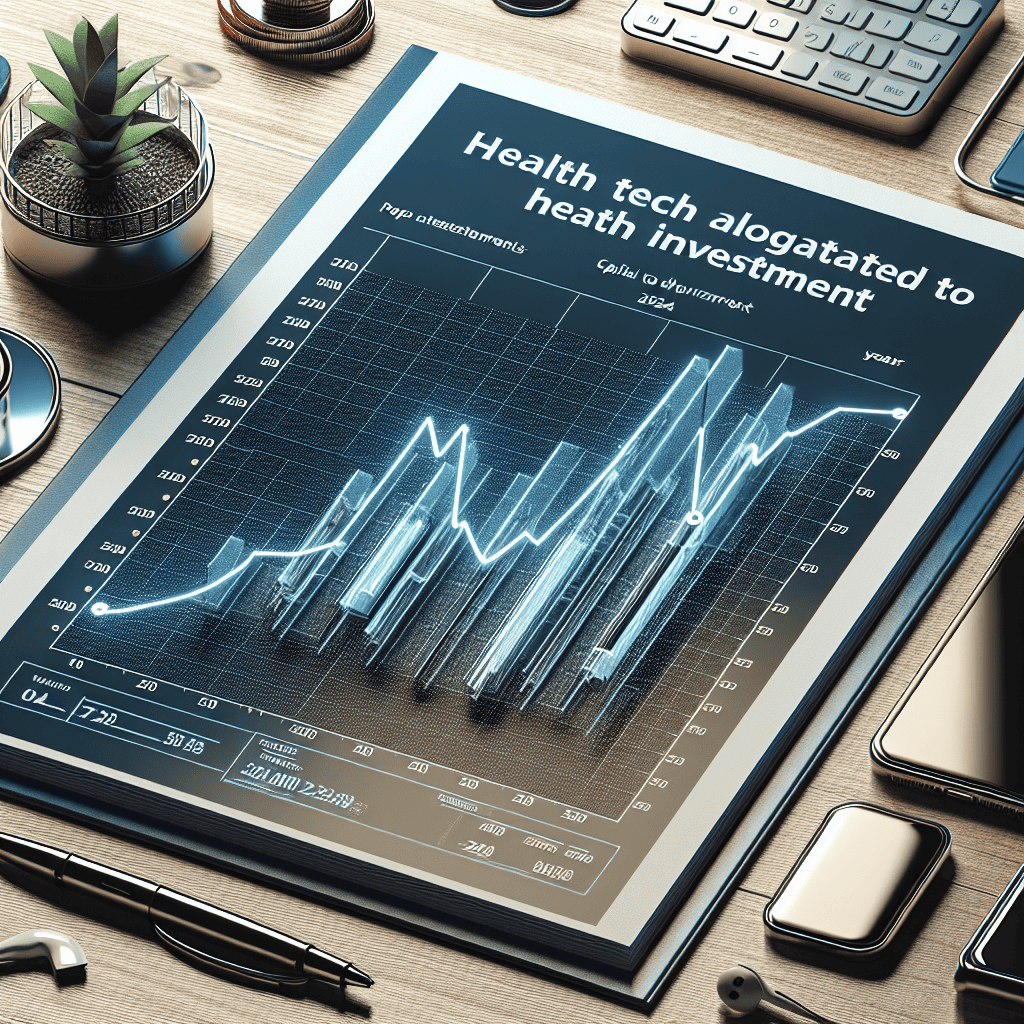Health Tech Investment Poised for Recovery in 2024: SVB Report

The health tech industry has been a focal point of innovation and investment over the past decade, driven by technological advancements and an increasing demand for efficient healthcare solutions. However, the sector faced significant challenges in recent years, particularly due to the global pandemic and economic uncertainties. According to a recent report by Silicon Valley Bank (SVB), health tech investment is poised for a robust recovery in 2024. This article delves into the key factors driving this resurgence, exploring various subtopics that highlight the potential for growth and innovation in the health tech sector.
1. The Current Landscape of Health Tech Investment
The health tech industry has experienced a rollercoaster of investment trends over the past few years. Initially, the COVID-19 pandemic accelerated the adoption of digital health solutions, leading to a surge in investment. However, as the pandemic’s immediate impact waned, the sector faced a slowdown in funding. The SVB report indicates that 2024 will mark a turning point, with several factors contributing to renewed investor interest.
One of the primary drivers of this recovery is the increasing integration of artificial intelligence (AI) and machine learning (ML) in healthcare. These technologies are revolutionizing diagnostics, treatment planning, and patient management, offering significant cost savings and improved outcomes. Investors are keen to capitalize on these advancements, recognizing the potential for substantial returns.
Moreover, the growing emphasis on personalized medicine is attracting investment. With the ability to tailor treatments to individual patients based on genetic, environmental, and lifestyle factors, personalized medicine promises to enhance efficacy and reduce adverse effects. This approach is gaining traction, with numerous startups and established companies focusing on developing innovative solutions.
Another factor contributing to the recovery is the increasing demand for telehealth services. The pandemic accelerated the adoption of virtual care, and this trend is expected to continue as patients and providers recognize the convenience and efficiency of remote consultations. Investors are eyeing opportunities in this space, particularly in developing markets where access to healthcare is limited.
Finally, regulatory support and policy changes are playing a crucial role in fostering investment. Governments worldwide are recognizing the importance of digital health solutions and are implementing policies to encourage innovation and adoption. This supportive environment is creating a fertile ground for investment, with companies poised to benefit from favorable regulations.
2. Key Drivers of Health Tech Investment Recovery
The anticipated recovery in health tech investment is underpinned by several key drivers that are reshaping the industry landscape. Understanding these drivers is essential for investors and stakeholders looking to capitalize on emerging opportunities.
Firstly, the aging global population is a significant driver of health tech investment. As life expectancy increases, there is a growing demand for healthcare services and solutions that cater to the needs of older adults. Technologies that address age-related conditions, such as chronic diseases and mobility issues, are attracting investment as they offer the potential to improve quality of life and reduce healthcare costs.
Secondly, the rise of consumer-driven healthcare is transforming the industry. Patients are increasingly taking control of their health, seeking information and solutions that empower them to make informed decisions. This shift is driving demand for digital health tools, such as wearable devices and health apps, which provide real-time data and insights. Investors are keen to support companies that are at the forefront of this consumer-centric approach.
Another critical driver is the increasing focus on mental health. The pandemic highlighted the importance of mental well-being, leading to a surge in demand for mental health services and solutions. Digital mental health platforms, which offer accessible and affordable care, are gaining traction and attracting investment. This trend is expected to continue as awareness of mental health issues grows.
Furthermore, the convergence of health tech with other industries, such as biotechnology and pharmaceuticals, is creating new opportunities for investment. This convergence is enabling the development of innovative solutions that combine the strengths of different sectors, leading to breakthroughs in areas such as drug discovery and precision medicine.
Lastly, the availability of data and advancements in data analytics are driving investment in health tech. The ability to collect, analyze, and interpret vast amounts of health data is transforming healthcare delivery and research. Companies that leverage data to develop predictive models and personalized interventions are attracting significant investment, as they offer the potential to revolutionize patient care.
3. Emerging Trends in Health Tech Innovation
The health tech sector is witnessing a wave of innovation, with several emerging trends shaping the future of healthcare. These trends are not only driving investment but also redefining how healthcare is delivered and experienced.
One of the most prominent trends is the rise of digital therapeutics. These software-based interventions are designed to prevent, manage, or treat medical conditions, offering a new approach to healthcare delivery. Digital therapeutics are gaining traction due to their ability to provide evidence-based interventions that are scalable and cost-effective. Investors are increasingly interested in this space, recognizing the potential for digital therapeutics to complement traditional treatments.
Another trend is the growing use of blockchain technology in healthcare. Blockchain offers a secure and transparent way to manage health data, ensuring privacy and interoperability. This technology is being used to streamline processes such as patient record management, clinical trials, and supply chain management. As the healthcare industry grapples with data security and interoperability challenges, blockchain is emerging as a promising solution, attracting investment from both traditional and venture capital sources.
The integration of virtual reality (VR) and augmented reality (AR) in healthcare is also gaining momentum. These technologies are being used for a range of applications, from surgical training and simulation to patient rehabilitation and pain management. VR and AR offer immersive experiences that enhance learning and engagement, making them valuable tools in healthcare settings. Investors are taking note of the potential for these technologies to transform patient care and medical education.
Additionally, the development of smart medical devices is revolutionizing healthcare delivery. These devices, which include connected wearables and implantable sensors, provide real-time monitoring and data collection, enabling proactive and personalized care. The ability to continuously track health metrics and detect anomalies is driving investment in smart medical devices, as they offer the potential to improve outcomes and reduce healthcare costs.
Finally, the rise of health tech ecosystems is fostering collaboration and innovation. These ecosystems bring together stakeholders from various sectors, including technology, healthcare, academia, and government, to drive the development and adoption of digital health solutions. By facilitating knowledge sharing and resource pooling, health tech ecosystems are creating a supportive environment for startups and established companies alike, attracting investment and accelerating innovation.
4. Case Studies: Successful Health Tech Investments
To illustrate the potential for growth and innovation in the health tech sector, it is valuable to examine case studies of successful investments. These examples highlight the diverse opportunities available to investors and the impact of strategic investments on healthcare delivery.
One notable case study is the investment in Teladoc Health, a leading telehealth company. Teladoc has experienced significant growth in recent years, driven by the increasing demand for virtual care services. The company’s platform offers a range of services, including primary care, mental health support, and chronic condition management. Teladoc’s success demonstrates the potential for telehealth to transform healthcare delivery, providing convenient and accessible care to patients worldwide.
Another successful investment is in the field of digital therapeutics, exemplified by Pear Therapeutics. Pear Therapeutics has developed a range of FDA-approved digital therapeutics for conditions such as substance use disorder and insomnia. These software-based interventions offer evidence-based treatments that complement traditional therapies. The company’s success highlights the potential for digital therapeutics to address unmet medical needs and improve patient outcomes.
The investment in Butterfly Network, a company specializing in portable ultrasound devices, is another compelling case study. Butterfly Network’s handheld ultrasound device, powered by AI, offers affordable and accessible imaging solutions. The company’s technology has the potential to democratize access to medical imaging, particularly in resource-limited settings. This investment underscores the impact of innovative medical devices on healthcare delivery and accessibility.
Additionally, the investment in Tempus, a company focused on precision medicine, showcases the potential of data-driven healthcare solutions. Tempus leverages AI and machine learning to analyze clinical and molecular data, providing insights that inform personalized treatment plans. The company’s platform is used by healthcare providers and researchers to improve patient outcomes and accelerate drug discovery. Tempus’s success demonstrates the transformative power of data analytics in healthcare.
Finally, the investment in Livongo Health, a company specializing in chronic disease management, highlights the potential for digital health platforms to improve patient engagement and outcomes. Livongo’s platform combines connected devices, data analytics, and personalized coaching to support individuals with chronic conditions such as diabetes and hypertension. The company’s success led to its acquisition by Teladoc Health, further emphasizing the value of integrated digital health solutions.
5. Challenges and Opportunities in Health Tech Investment
While the health tech sector presents significant opportunities for investment, it also faces several challenges that investors must navigate. Understanding these challenges and opportunities is crucial for making informed investment decisions.
One of the primary challenges is the regulatory landscape. The healthcare industry is heavily regulated, and navigating the complex regulatory environment can be daunting for health tech companies. Ensuring compliance with regulations such as HIPAA in the United States and GDPR in Europe is essential for protecting patient data and maintaining trust. Investors must consider the regulatory risks associated with health tech investments and support companies in developing robust compliance strategies.
Another challenge is the integration of new technologies into existing healthcare systems. Health tech solutions must be interoperable with legacy systems to ensure seamless data exchange and workflow integration. This requires collaboration between technology providers, healthcare organizations, and policymakers to establish standards and frameworks that facilitate interoperability. Investors can play a role in supporting companies that prioritize interoperability and collaboration.
Data privacy and security are also critical concerns in the health tech sector. The increasing use of digital health solutions raises questions about data ownership, consent, and protection. Companies must implement robust security measures to safeguard patient data and comply with privacy regulations. Investors should prioritize companies that demonstrate a commitment to data privacy and security, as these factors are essential for building trust with patients and providers.
Despite these challenges, the health tech sector offers numerous opportunities for investment. The growing demand for personalized and preventive care is driving innovation in areas such as genomics, wearables, and remote monitoring. Companies that develop solutions that empower patients to take control of their health are well-positioned for success.
Additionally, the increasing focus on value-based care is creating opportunities for health tech companies that can demonstrate improved outcomes and cost savings. Solutions that enable providers to deliver high-quality care while reducing costs are attracting investment, as they align with the goals of healthcare systems worldwide.
Finally, the global nature of healthcare presents opportunities for health tech companies to expand into new markets. Emerging markets, in particular, offer significant growth potential due to increasing healthcare needs and limited access to traditional healthcare services. Investors can support companies that are exploring international expansion and adapting their solutions to meet the needs of diverse populations.
Conclusion
The SVB report highlights the potential for a robust recovery in health tech investment in 2024, driven by technological advancements, changing consumer preferences, and supportive regulatory environments. The health tech sector is poised for growth, with opportunities in areas such as AI, personalized medicine, telehealth, and digital therapeutics. However, investors must navigate challenges related to regulation, interoperability, and data privacy to capitalize on these opportunities.
Successful investments in companies like Teladoc Health, Pear Therapeutics, Butterfly Network, Tempus, and Livongo Health demonstrate the transformative impact of health tech solutions on healthcare delivery and patient outcomes. As the industry continues to evolve, investors have the opportunity to support innovative companies that are shaping the future of healthcare.
In conclusion, the health tech sector offers a compelling investment landscape, with the potential to drive significant improvements in healthcare access, quality, and efficiency. By understanding the key drivers, emerging trends, and challenges, investors can make informed decisions and contribute to the advancement of healthcare technology.





